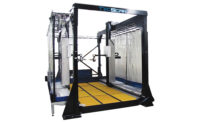NDT Applications: Old Technology Produces State-of-the-Art Quality
The productive possibilities of combining riveting and electronics are demonstrated in a series of applications developed by Interwest Automation (Red Oak, IA) for the automotive seating industry. Based on a family of multi-axis electromechanical presses and a specialized multi-axis controller from Promess Inc. (Brighton, MI), Interwest's systems are used to assemble and test key seating components, including the critical latches that control seatback movement.
Latches can be a difficult application, requiring strength and durability combined with a very narrow range of actuation effort on the part of the manufacturer. Apply too much peen, and the latch is difficult to operate, creating a customer satisfaction issue. Apply too little and the assembly is not reliable, which can be a safety issue, as well as a customer satisfaction issue. Getting the latch just right in millions of assemblies is a difficult challenge.
The Interwest solution uses a Promess electromechanical assembly press (EMAP) system to drive an orbital riveting head mounted on the ram of a conventional riveting press. The EMAP has integrated sensors and provides closed-loop feedback for accurate control of the riveting operation.
Connecting the EMAP to a Promess electromechanical assembly controller (EMAC) creates a completely closed-loop system, capable of monitoring and controlling the entire riveting operation to produce consistent assemblies. The EMAC provides both the control capability, and the real-time process monitoring intelligence required to make the application work.
The next step and key to the success of Interwest's systems is a technology called signature analysis, in which the characteristics of a known good operation are captured and used as a benchmark for subsequent production operations. By setting upper and lower tolerance limits, good assembly production is ensured without the need for subsequent inspection.
The EMAP delivers real-time torque and position information to the EMAC, which continuously compares that information to the profile of the nominal operation. Any deviation beyond programmable limits will flag the assembly as a potential problem and alert the system operator.
The process, developed by Promess, essentially clones a good operation by ensuring that all subsequent operations exhibit a similar torque and distance signature curve. The monitoring software in the EMAC unit allows this to be done in real time.
Signature analysis can detect potentially bad assemblies and frequently pinpoint the cause of an out-of-signature event. The exact shape of the signature provides important information about the individual parts being assembled, which can be used as a control input to other processes. For example, rivets that are too hard or soft, or too short or long, will produce a distinct change in the signature, as will out-of-tolerance details such as hole diameters. Assembly and component trends can be tracked by signature analysis technology as well.
Interwest's three-axis orbital riveting station is designed to handle a range of rivets of different sizes in multiple locations on assemblies such as a seat-back latch. The programmable system can accommodate rivets of different lengths and diameters anywhere within its working envelope.
Each of the rivets on the assembly is analyzed individually and compared to a nominal torque and distance signature for that specific rivet. The result is either a certified "good" assembly or a fault-identified reject for every machine cycle.
In this application, the Promess EMAC controls both the electromechanical press with the orbital riveting operation and the X-Y motion of the pallet, and performs the signature analysis operation. This gives the manufacturer a common interface for all motion programming. The system is easily reconfigured to handle a variety of parts by changing the pallets that carry the work-holding fixtures and reprogramming the control.
Sidebar: Benefits
The updated riveting system costs less than other assembly systems.Combining EMAP and EMAC creates a closed-loop system that controls the entire riveting operation.
Signature analysis helps eliminate the need for subsequent inspections.
Looking for a reprint of this article?
From high-res PDFs to custom plaques, order your copy today!



